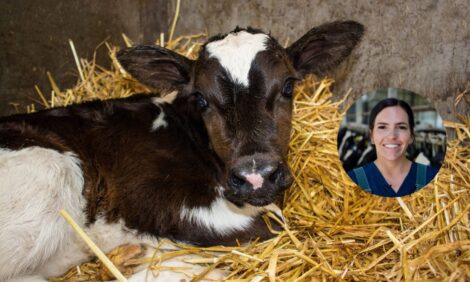



Dairy Industry Sets Ambitious Targets to Reduce Emissions
ANALYSIS - The British dairy industry is set to reduce greenhouse gas emissions by between 20 and 30 per cent on 1990 levels by 2020.By 2025 90 per cent of dairy farmers in the UK will be implementing technologies and practices to reduce emissions from agriculture according to the latest Dairy Roadmap launched this week by the National Farmers Union, Dairy UK and the Agricultural and Horticultural Development Board.
In the review of the measures taken over the last two years, the latest roadmap shows that 90 per cent of farmers are actively nutrient management planning and 65 per cent of the dairy managed farmland is now under environmental stewardship schemes.
In 2013, 75 per cent on farmers were nutrient management planning.
The roadmap shows that good nutrient management can bring benefits including the minimisation of greenhouse gas emissions and a reduction in water pollution as well as helping farmers to save money by optimising the nutrients used.
Rob Harrison, the chairman of the Dairy Roadmap and the chairman of the National Farmers Union Dairy Board said that the loss of the Entry Level Stewardship scheme meant setting more targets for farmers.
However he said that he believed that more and more dairy farmers will become involved with biodiversity measures as well as continue to reduce waste and emissions.
“It is down to us to improve the industry and show the way forward,” he said.
He said that the future relies on businesses operating to world leading standards while at the same time minimising the impact of dairy production on the environment.
The report shows that between 10 and 15 per cent of dairy farmers are implementing at least one form of renewable energy technology, while a third of all farmers in England and Wales are generating renewable energy.
The roadmap findings also show a 70 per cent uptake of water efficiency measures including rainwater harvesting, reusing water from a plate-cooler and using water from a borehole.
Research from the advisory body ADAS has shown that dairy farms pay between £31 and £100 per cow for water use each year, but 20 per cent of this usage could be met through rainwater sources.
More than half of the British dairy farms are now using new technology to help reduce emissions from agriculture in particular by concentrating on feed quality and digestibility, animal health and husbandry, manure management and collection, storage and use and precision livestock farming.
The report says that feed and nutrition directly affects an animal’s productivity and can strongly affect GHG emissions.
And grazing management, improving forage quality to make the most of the mix all contribute to improved efficiency in the dairy system.
“This can substantially increase feed efficiency and production, resulting in reduced emissions,” the report says.
“Customised balanced feeding programmes in dairy cattle have been shown to be effective at increasing productivity and reducing methane emissions intensity (by between 15-20 per cent) and also nitrogen excretion by 20-30 per cent as a result of reduced emissions from manure.”
The Dairy Roadmap shows that there has been a fall in the number of serious pollution incidents caused by farming and there is now encouragement for dairy farmers to calculate their carbon footprint and implement carbon reduction programmes.
The target set for 202p is to reduce GHG emissions from dairy farms by 30 per cent and to have 70 per cent of non-natural waste recovered or recycled as practice.
The dairy industry also wants to see a 90 per cent uptake in water use efficiency and 40 per cent of energy used on dairy farms from renewable sources.
By 2025 the target is for 90 per cent of dairy farmers to be using technology and practices to reduce emissions with 85 per cent of dairy farmers using expert advice to optimise feed plans and 95 per cent using water efficiency methods.
On the processing side the roadmap targets for this year were to have Environmental Management Systems covering carbon, energy waste, effluent and packaging in place for every large processing site.
Targets were also set for a 20 per cent reduction in water brought onto sites and to have 30 per cent of high density polyethylene milk bottles made from recycled material.
The targets for 2020 are to achieve a 15 per cent improvement in energy efficiency, 30 per cent reduction in the amount of water brought into the plant, a 20mper cent reduction in chemical oxygen demand , 50m per cent of the milk bottles made from recycled material and cartons to be Forestry Stewardship Certified..
By 2025 the processing side of the dairy industry wants to achieve a 30 per cent reduction in carbon related energy use and a 30 per cent reduction in the water brought into the plant as well as a 30 per cent reduction in food waste from the plant.
The processing sector is also encouraging plants to invest in biodiversity and maximise the recycled content of packaging.
“Looking back at the progress we’ve all made since Dairy UK, AHDB Dairy and the NFU produced the very first environmental Roadmap – the Milk Roadmap in 2008, we can be proud of our industry’s accomplishments.
“Our commitment to tackling the environmental challenges of food production is strong and the 2015 Dairy Roadmap report shows compelling evidence of that commitment,” said Dr Judith Bryans, chief executive of Dairy UK, who will head up the roadmap developments for the next two years.
"Dairy processors have made great progress in waste prevention and reduction. Segregation of mixed waste, employee engagement activities – and that means relatively simple things like educating employees about the true cost of waste to the business, and asking them to spot waste in processes used alongside measures such as greater use of energy from waste incineration and AD technology means that dairy processors are now sending only four per cent of factory waste to landfill down from 32 per cent in 2008.”
Dr Bryans added: “Dairy UK launched an ambitious biodiversity strategy for the dairy processing sector.
“We recognise that dairy farms represent the greatest opportunity to enhance biodiversity in rural areas. However, dairy processors can play an important role in enhancing biodiversity across their sites and in their local communities.”
Dairy UK, the NFU and AHDB Dairy is now to start monitoring and measuring the impact of all activities as set out in the 2025 targets.
“We’ve worked hard to develop these new targets to help drive sustainable progress across the industry so we need to make sure that progress is recorded from the outset,” Dr Bryans said.
“We’re mindful of the fact that the environment and sustainability will become increasingly important for policy makers and consumers and that as an industry we must keep our efforts relevant. We will therefore collaboratively review the Roadmap and look at potential of adding new areas of focus. For example, packaging innovation and sustainability training.
“We have seen other countries such as Ireland stand on its sustainability credentials abroad when promoting their products.
“The UK must do the same.”



